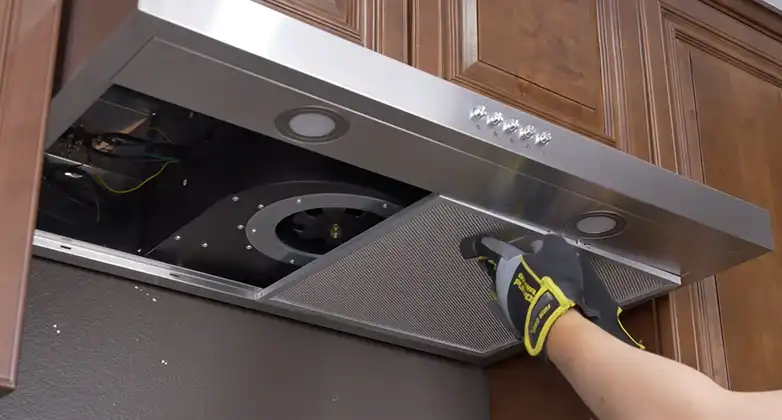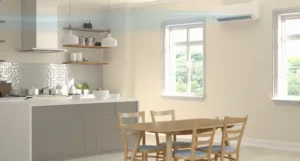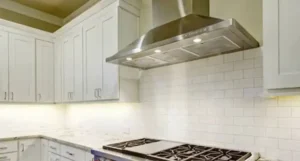In the realm of kitchen appliances, one often underappreciated yet essential piece of equipment is the hood vent. You might find yourself pondering whether investing in a hood vent is truly worth it.
Hood Vetns are certainly worth it if you value air quality and the added convenience while cooking.
Below, we will discuss hood vents, exploring their benefits, types, installation nuances, maintenance requirements, and cost considerations, and even address common queries.

The Benefits of Hood Vents
Below we will discuss the benefits of installing a hood vent so that you can understand if you really need to install one or if the additional cost is not worth it for you.
Improved Air Quality
When you cook, your kitchen can become a battleground of lingering odors and airborne particles. Hood vents play a vital role in mitigating this issue. They effectively whisk away smoke, cooking odors, and grease-laden air, ensuring your kitchen remains fresh and comfortable. Beyond mere convenience, this contributes to a healthier indoor environment by reducing indoor air pollutants and improving overall air quality.
Temperature Regulation
Imagine, a sizzling pan, a pot of boiling water, and a steamy oven—all contributing to the rising temperature in your kitchen. Hood vents help maintain a comfortable cooking environment by expelling heat, and keeping your kitchen cooler. Not only does this enhance your comfort while preparing meals, but it also lowers your energy bills, as your air conditioning system doesn’t have to work as hard to maintain a pleasant temperature.
Enhanced Safety
Safety is paramount in the kitchen, and hood vents play a crucial role in this regard. They help prevent the accumulation of grease on surfaces and potential dangers associated with the release of cooking fumes. In addition to enhancing kitchen safety, hood vents can serve as a fire prevention measure, reducing the risk of accidents.
Types of Hood Vents
Not all hood vents are created equal. So you need to understand their types if you want to get one that best suits your needs.
Under-Cabinet Hood Vents
For kitchens with limited space, under-cabinet hood vents are a practical choice. These units are installed beneath kitchen cabinets and offer various design options to seamlessly blend with your kitchen’s aesthetics. Their compact size makes them suitable for smaller kitchens.
Wall-Mounted Hood Vents
If your kitchen has a range positioned against a wall, wall-mounted hood vents are the way to go. They not only efficiently capture and expel cooking byproducts but also offer design flexibility to complement your kitchen’s style. These vents are often chosen for their aesthetic appeal.
Island Hood Vents
Kitchens with cooktops on islands can benefit from island hood vents. These stylish installations not only serve their primary purpose but also add an element of sophistication to your kitchen. However, they come with unique challenges in terms of installation and design choices.
Downdraft Hood Vents
In open kitchen layouts, downdraft hood vents are a space-saving option. Instead of being mounted above the cooking surface, they retract when not in use, providing a minimalist appearance. While they offer aesthetic advantages, it’s essential to weigh their pros and cons, including their ability to efficiently capture cooking byproducts.
Hood Vent Installation Considerations
Professional vs. DIY Installation
The decision between professional and DIY installation depends on your skills, experience, and the complexity of the installation. While some homeowners may opt for DIY installation to save on costs, hiring a professional installer ensures that the hood vent functions optimally and complies with safety standards.
Location and Sizing
Determining the right placement for your hood vent is crucial for its effectiveness. Proper sizing and placement ensure efficient capture of cooking byproducts. Consulting with an expert can help you make the best decisions based on your kitchen’s layout.
Venting Options
Hood vents can be ducted or ductless. Ducted vents expel air outdoors through a duct system, while ductless vents filter and recirculate air back into the kitchen. Your choice depends on your kitchen’s layout and your preference for venting.
Hood Vents Maintenance and Care
Cleaning and Filter Replacement
Maintaining your hood vent is essential for optimal performance. Regular cleaning and filter replacement are necessary tasks. The frequency of these tasks may vary depending on your cooking habits and the type of hood vent you have. Understanding the cleaning requirements for your specific model is crucial.
Troubleshooting Common Issues
Even with proper maintenance, hood vents may encounter issues. Identifying and addressing common problems such as fan malfunctions, filter clogs, or unusual noises is vital to ensure your hood vent continues to operate effectively. In some cases, professional assistance may be necessary.
Vent Hood Cost and Budgeting
Initial Costs
Investing in a hood vent involves both the purchase price of the unit and installation costs. Budgeting for these expenses is essential. The initial cost can vary significantly based on factors such as the type of hood vent, brand, and complexity of installation.
Long-Term Savings
While the initial investment in a hood vent may seem substantial, it’s essential to consider the long-term savings. Hood vents contribute to energy efficiency by reducing the load on your HVAC system and preventing the need for excessive cleaning and maintenance. Additionally, they can enhance your kitchen’s value, making it a worthwhile investment.
When Vent Hood is Worth It?
When Cooking Frequency Is High
If you’re an avid cook or frequently prepare meals at home, a hood vent becomes an invaluable addition to your kitchen. Its ability to rapidly eliminate cooking odors and maintain a pleasant environment significantly enhances your cooking experience.
In Open Kitchen Designs
Open kitchen layouts have gained popularity in recent years. If you have an open kitchen, a hood vent is almost a necessity. It not only keeps cooking byproducts from spreading to other living spaces but also complements the overall design, making it a worthwhile addition.
When Vent Hood is Not Worth It?
In Minimalist or Compact Kitchens
In minimalist or compact kitchens, every inch of space counts. If your kitchen design prioritizes simplicity and space efficiency, you might find that a hood vent disrupts the clean lines and aesthetic you desire. In such cases, alternative ventilation methods may be more suitable.
When Budget Constraints Are High
If you’re working with a tight budget and other kitchen improvements take precedence, you might opt to postpone or forego a hood vent installation. While hood vents offer numerous benefits, there are lower-cost alternatives and creative solutions to consider until your budget allows for a hood vent investment.
Advantages and Disadvantages of Hood Vents
Advantages
Improved Air Quality and Comfort: Hood vents ensure that your kitchen remains fresh and comfortable by removing smoke, odors, and heat.
Enhanced Kitchen Safety: They prevent the buildup of grease and potentially dangerous fumes.
Increased Property Value: Hood vents can enhance the value of your home, making it a more appealing prospect for potential buyers.
Disadvantages
Initial Cost and Installation Challenges: The upfront cost of purchasing and installing a hood vent can be substantial, and installation complexity can vary.
Ongoing Maintenance Requirements: Regular cleaning and filter replacement are necessary for optimal performance.
Space Considerations: In smaller or minimalist kitchens, a hood vent may disrupt the desired aesthetic and space efficiency.
People Also Ask
How loud are hood vents, and can I reduce the noise?
Hood vents can vary in noise levels depending on the model. To reduce noise, consider models with quieter fan settings and soundproofing solutions during installation.
Are there options for remote control or smart hood vents?
Yes, many modern hood vents come with remote control and smart features, allowing you to adjust settings conveniently from a distance or using smartphone apps.
What are the maintenance costs associated with hood vents?
Maintenance costs for hood vents primarily include cleaning and occasional filter replacement. The frequency of maintenance varies based on your cooking habits and the type of hood vent.
Can I install a hood vent in an existing kitchen without one?
Yes, it is possible to retrofit a hood vent into an existing kitchen without one. However, the feasibility of installation depends on the kitchen’s layout and access to ductwork.
Do hood vents require permits or compliance with building codes?
Depending on your location and local regulations, you may need permits for hood vent installation to ensure compliance with building codes. It’s essential to research and adheres to local requirements.
In Summary
Investing in a hood vent for your kitchen is not just about aesthetics; it’s a practical decision that can significantly improve air quality, safety, and your overall cooking experience. Whether you’re concerned about lingering odors, maintaining a comfortable cooking environment, or enhancing your kitchen’s value, a well-chosen hood vent can be a worthwhile investment. With the information provided in this comprehensive guide, you now have the knowledge to make an informed decision that aligns with your kitchen’s unique needs and your overall home improvement goals.

![Read more about the article [4 Fixes] Why Won’t My Range Hood Fan Turn Off?](https://kitchenhoodcare.com/wp-content/uploads/2023/05/Why-Wont-My-Range-Hood-Fan-Turn-Off-300x161.webp)

